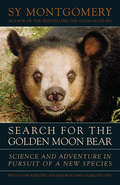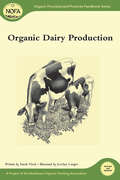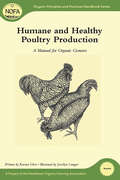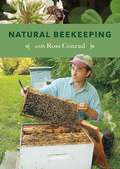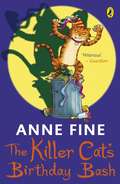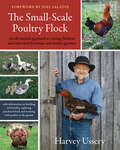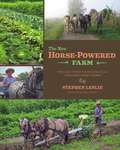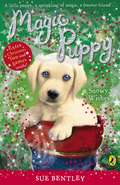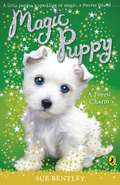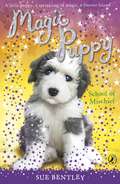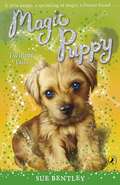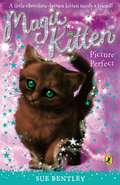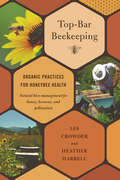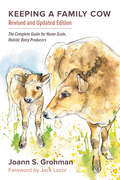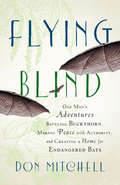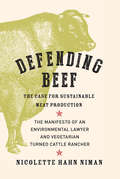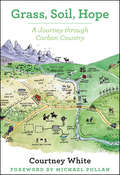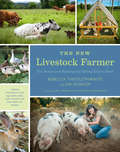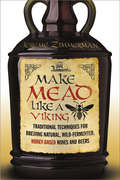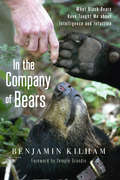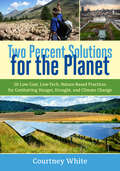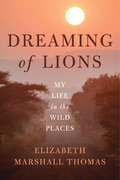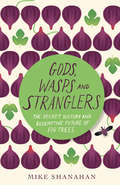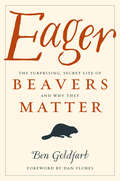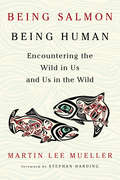- Table View
- List View
Search for the Golden Moon Bear: Science and Adventure in Pursuit of a New Species
by Sy Montgomery Gary GalbreathSy Montgomery--acclaimed author of The Soul of an Octopus and bestselling memoir The Good Good Pig--has shared with readers her amazing encounters with intelligent octopi, great apes, man-eating tigers, and pink river dolphins, but here her muse is an animal whose name and appearance evoke another world altogether. Southeast Asia's golden moon bear, with its luminous coat, lionlike mane, and Mickey Mouse ears, was unknown to science--until Montgomery and her colleagues got on the trail at the dawn of the new millennium. Search for the Golden Moon Bear recounts Montgomery's quest--fraught with danger and mayhem--to reconstruct an evolutionary record and piece together a living portrait of her littleknown subject. This beautiful animal is not just a scientific eureka! It is also a powerful symbol of conservation. Search for the Golden Moon Bear is a field report from the frontiers of science and the ends of the earth, seamlessly weaving together folklore, natural history, and contemporary research into fantastic travelogue.
Organic Dairy Production (Organic Principles and Practices Handbook Series)
by Sarah Flack Jocelyn LangerPart of the NOFA guides. Includes information on: Soils, the foundation of health (manure management) Crop production and grazing management (forage species, pasture management, setting up a grazing system) Livestock (selection, nutrition, winter and summer feed considerations, seasonal milking, habitat, herd health, milk quality) Marketing (selling fluid milk, regulations, facility and equipment, selling raw milk) Recordkeeping The transition to organic Featuring examples from various farms in the Northeast.
Humane and Healthy Poultry Production: A Manual for Organic Growers (Organic Principles and Practices Handbook Series)
by Karma Glos Jocelyn LangerPart of the NOFA guides. Includes information on: Organic poultry basics Establishing the facilities (housing and equipment, choosing and using litter, outdoor access, brooding, grazing and pasturing) Purchasing and brooding chicks Organic feed and supplements Poultry health care in the organic system Management challenges (production and culling, spotted shells, yolk color) Slaughter and Processing Marketing Production expectations and economic viability
Natural Beekeeping: Organic Approaches to Modern Apiculture, 2nd Edition
by Ross Conrad Gary Paul NabhanToday's beekeepers face unprecedented challenges, a fact that is now front-page news with the spread of "colony collapse disorder." Newly introduced pests like varroa and tracheal mites have made chemical treatment of hives standard practice, but pest resistance is building, which in turn creates demand for new and even more toxic chemicals. In fact, there is evidence that chemical treatments are making matters worse. It's time for a new approach. Now revised and updated with new resources and including full-color photos throughout, Natural Beekeeping offers all the latest information in a book that has already proven invaluable for organic beekeepers. The new edition offers the same holistic, sensible alternative to conventional chemical practices with a program of natural hive management, but offers new sections on a wide range of subjects, including: The basics of bee biology and anatomy Urban beekeeping Identifying and working with queens Parasitic mite control Hive diseases Also, a completely new chapter on marketing provides valuable advice for anyone who intends to sell a wide range of hive products.Ross Conrad brings together the best "do no harm" strategies for keeping honeybees healthy and productive with nontoxic methods of controlling mites; eliminating American foulbrood disease without the use of antibiotics; selective breeding for naturally resistant bees; and many other detailed management techniques, which are covered in a thoughtful, matter-of-fact way. Whether you are a novice looking to get started with bees, an experienced apiculturist looking for ideas to develop an integrated pest-management approach, or someone who wants to sell honey at a premium price, this is the book you've been waiting for.
The Killer Cat's Birthday Bash (The\killer Cat Ser.)
by Anne FineIt was my birthday. How was I supposed to know it wouldn't be the only party around town on that dark and dreary Halloween night?So things ended up in a bit of a mess. (Well, more than a mess, really. A complete disaster.) But it was not my fault so don't blame me . . .Another laugh-out-loud Killer Cat adventure, by the award-winning and celebrated Anne Fine. Perfect for readers of 7+.
The Small-Scale Poultry Flock: An All-Natural Approach to Raising Chickens and Other Fowl for Home and Market Growers
by Harvey Ussery Joel SalatinThe most comprehensive guide to date on raising all-natural poultry for the small-scale farmer, homesteader, and professional grower. The Small-Scale Poultry Flock offers a practical and integrative model for working with chickens and other domestic fowl, based entirely on natural systems. Readers will find information on growing (and sourcing) feed on a small scale, brooding (and breeding) at home, and using poultry as insect and weed managers in the garden and orchard. Ussery's model presents an entirely sustainable system that can be adapted and utilized in a variety of scales, and will prove invaluable for beginner homesteaders, growers looking to incorporate poultry into their farm, or poultry farmers seeking to close their loop. Ussery offers extensive information on: The definition of an integrated poultry flock (imitation of natural systems, integrating patterns, and closing the circle) Everything you need to know about your basic chicken (including distinctive points about anatomy and behavior that are critical to management) Extended information on poultry health and holistic health care, with a focus on prevention Planning your flock (flock size, choosing breeds, fowl useful for egg vs. meat production, sourcing stock) How to breed and brood the flock (including breeding for genetic conservation), including the most complete guide to working with broody hens available anywhere Making and mixing your own feed (with tips on equipment, storage, basic ingredients, technique, grinding and mixing) Providing more of the flock's feed from sources grown or self-foraged on the homestead or farm, including production of live protein feeds using earthworms and soldier grubs Using poultry to increase soil fertility, control crop damaging insects, and to make compost-including systems for pasturing and for tillage of cover crops and weeds Recipes for great egg and poultry dishes (including Ussery's famous chicken stock!) And one of the best step-by-step poultry butchering guides available, complete with extensive illustrative photos. No other book on raising poultry takes an entirely whole-systems approach, or discusses producing homegrown feed and breeding in such detail. This is a truly invaluable guide that will lead farmers and homesteaders into a new world of self-reliance and enjoyment.
The New Horse-Powered Farm: Tools and Systems for the Small-Scale, Sustainable Market Grower
by Stephen Leslie Lynn MillerIn an era when fuel is a primary concern, draft horses are seen by many as the solution to small-scale, resilient farming with a closed-loop system. Horses bring farmers back to the roots of what it means to work the land and present a viable model for a small farm that lasts, while offering enjoyment for the whole family. This is the first book of its kind, offering wisdom and techniques for using horse power on the small farm or homestead, from longtime horse farmer Stephen Leslie. The New Horse-Powered Farm sets the stage for incorporating draft power on the farm by presenting tips on getting started with horses, care of the work horse, different horse-training systems, and the merits of different draft breeds. The novice teamster is introduced to the basic tools of horse-drawn tillage and cultivation used for profitable horse-powered farming, with a spotlight on whole-farm management, as well as information on haying with horses, raising small grains, managing the woodlot, farm education, agritourism, and more. Incorporated throughout are profiles of more than a half-dozen farms that epitomize some exciting new trends in agriculture and highlight the new and old horse-drawn equipment used for profitable market gardening, including contributions directly from the farmers about what works and what doesn't. The novice teamster is introduced to the specifics of horse-drawn tillage and cultivation of the market garden, and using horses in the woodland. Recent studies on the economics of horse-powered market gardening and a comparison between horse-, human-, and tractor-powered systems have been included to help round out the picture. The resources section lists contact info for teamster schools, books, draft-animal publications, annual events, equipment manufacturers, parts and repairs, and more. A must-have for any farmer, homesteader, or teamster seeking to work with draft power in a closed-loop farming system.
Magic Puppy: A Christmas Surprise And Snowy Wishes (Magic Puppy #9)
by Sue BentleyA fabulously festive Magic Puppy Christmas special.Robyn is feeling horrible. It's Christmas and she's stuck on a family cruise with very bad sea-sickness. But when Storm, a fluffy white labrador puppy, magically appears, Robyn decides to leave all her troubles at sea. She and Storm soon meet Krista, from Lapland, and a truly magical Christmas adventure begins...
Magic Puppy: A Forest Charm (Magic Puppy #6)
by Sue BentleyBark for joy at the arrival of this grrreat magical new series! A sequel to the bestselling sensation, Magic Kitten.Storm is the only young wolf left from his family in the magic Moon-claw pack after the evil wolf, Shadow, wounds his mother and destroys everyone else. With the rest of the pack now scattered, Storm's mother is too weak to protect Storm so she sends him to our world as a magic puppy where his magical powers can grow. But Storm must find a friend here to help him hide from the evil Shadow. Will Storm be able to hide long enough to eventually return and save his mother and the magical Moon-claw pack?The sixth title in this brilliant new series that will leave you howling for more!
Magic Puppy: School of Mischief (Magic Puppy #8)
by Sue BentleyA world of magic, adventure and cute puppy antics from the bestselling author of the Magic Kitten series.Freya and her family have moved to be nearer her grandma and Freya is really missing her friends. Even new neighbour Isaac and his naughty puppy, Teddy, can't cheer her up. But when Old English sheepdog puppy Storm arrives, Freya's world becomes filled with magical fun!
Magic Puppy: Twirling Tails (Magic Kitten #7)
by Sue BentleyBark for joy at this grrreat magical new series! A sequel to the bestselling sensation, Magic Kitten.Kirsten loves being in the Limelight Majorettes with her best friend, Tracy. But when only Kirsten is chosen to be in the town parade, Tracy doesn't seem to want to be friends any more. Can the appearance of Storm, a honey-coloured Border Terrier puppy brighten up Kirsten's days?
Magic Kitten: Picture Perfect (Magic Kitten #14)
by Sue BentleyA purrfect series filled with chaos, adventure and magic spells!Orla is very excited about entering the local photo competition - especially since it's her chance to show that she can be as good at something as her sister. When she forgets to even take the lens cap off the camera, though, it isn't a good sign! But when little chocolate-brown kitten Flames comes into the picture, it looks like Orla's dreams of winning the competiton might just come true . . .
Top-Bar Beekeeping: Organic Practices for Honeybee Health
by Les Crowder Heather HarrellIn recent years beekeepers have had to face tremendous challenges, from pests such as varroa and tracheal mites and from the mysterious but even more devastating phenomenon known as Colony Collapse Disorder (CCD). Yet in backyards and on rooftops all over the world, bees are being raised successfully, even without antibiotics, miticides, or other chemical inputs.More and more organically minded beekeepers are now using top-bar hives, in which the shape of the interior resembles a hollow log. Long lasting and completely biodegradable, a topbar hive made of untreated wood allows bees to build comb naturally rather than simply filling prefabricated foundation frames in a typical box hive with added supers. Top-bar hives yield slightly less honey but produce more beeswax than a typical Langstroth box hive. Regular hive inspection and the removal of old combs helps to keep bees healthier and naturally disease-free. Top-Bar Beekeeping provides complete information on hive management and other aspects of using these innovative hives. All home and hobbyist beekeepers who have the time and interest in keeping bees intensively should consider the natural, low-stress methods outlined in this book. It will also appeal to home orchardists, gardeners, and permaculture practitioners who look to bees for pollination as well as honey or beeswax.
Keeping a Family Cow: The Complete Guide for Home-Scale, Holistic Dairy Producers, 3rd Edition
by Joann S. GrohmanThe cow is the most productive, efficient creature on earth. She will give you fresh milk, cream, butter, and cheese, build human health and happiness, and even turn a profit for homesteaders and small farmers who seek to offer her bounty to the local market or neighborhood. She will provide rich manure for your garden or land, and will enrich the quality of your life as you benefit from the resources of the natural world. Quite simply, the family that keeps a cow is a healthy family. Originally published in the early 1970s as The Cow Economy and reprinted many times over, Keeping a Family Cow has launched thousands of holistic small-scale dairy farmers and families raising healthy cows in accordance with their true nature. The book offers answers to frequently asked questions like, 'Should I get a cow?' and 'How Much Space do I need?' in addition to extensive information on: • The health benefits of untreated milk; • How to milk a cow effectively and with ease; • Choosing your dairy breed; • Drying off your cow; • Details on calving and breeding; • The importance of hay quality and how to properly feed your cow; • Fencing and pasture management; • Housing, water systems, and other supplies; • Treating milk fever and other diseases and disorders; • Making butter, yogurt, and cheese, and, of course . . . • . . . Everything else the conventional dairy industry doesn’t tell us! Now revised and updated to incorporate new information on the raw milk debate, the conversation about A1 vs. A2 milk, fully grassfed dairies, more practical advice for everyday chores, and updated procedures for cow emergencies. Keeping a Family Cow has not only stood the test of time, it still remains the go-to inspirational manual for raising a family milk cow nearly forty years after its first publication. Joann Grohman has a lifetime of practical experience that has been bound into this one volume and presented in the spirit of fun and learning.
Flying Blind: One Man's Adventures Battling Buckthorn, Making Peace with Authority, and Creating a Home for Endangered Bats
by Don MitchellWhen Middlebury writing professor Don Mitchell was approached by a biologist with the Vermont Fish and Wildlife Department about tracking endangered Indiana bats on his 150-acre farm in Vermont's picturesque Champlain Valley, Mitchell's relationship with bats—and with government—could be characterized as distrustful, at best. But the flying rats, as Mitchell initially thinks of them, launched him on a series of "improvements" to his land that would provide a more welcoming habitat for the bats—and a modest tax break for himself and his family. Whether persuading his neighbors to join him on a "silent meditation," pulling invasive garlic mustard out of the ground by hand, navigating the tacit ground rules of buying an ATV off Craigslist, or leaving just enough honeysuckle to give government inspectors "something to find," Mitchell’s tale is as profound as it is funny—a journey that changes Mitchell’s relationship with Chiroptera, the land, and, ultimately, his understanding of his own past. Ruminating on the nature of authority, the purview of the state, and the value of inhabiting one’s niche—Mitchell reveals much about our inner and outer landscape, in this perfectly paced and skilled story of place.
Defending Beef: The Case for Sustainable Meat Production
by Nicolette Hahn NimanFor decades it has been nearly universal dogma among environmentalists and health advocates that cattle and beef are public enemy number one. But is the matter really so clear cut? Hardly, argues environmental lawyer turned rancher Nicolette Hahn Niman in her new book, Defending Beef. The public has long been led to believe that livestock, especially cattle, erode soils, pollute air and water, damage riparian areas, and decimate wildlife populations. In Defending Beef, Hahn Niman argues that cattle are not inherently bad for either the Earth or our own nutritional health. In fact, properly managed livestock play an essential role in maintaining grassland ecosystems by functioning as surrogates for herds of wild ruminants that once covered the globe. Hahn Niman argues that dispersed, grass-fed, small-scale farms can and should become the basis for American food production, replacing the factory farms that harm animals and the environment. The author—a longtime vegetarian—goes on to dispel popular myths about how eating beef is bad for our bodies. She methodically evaluates health claims made against beef, demonstrating that such claims have proven false. She shows how foods from cattle—milk and meat, particularly when raised entirely on grass—are healthful, extremely nutritious, and an irreplaceable part of the world’s food system. Grounded in empirical scientific data and with living examples from around the world, Defending Beef builds a comprehensive argument that cattle can help to build carbon-sequestering soils to mitigate climate change, enhance biodiversity, help prevent desertification, and provide invaluable nutrition. Defending Beef is simultaneously a book about big ideas and the author’s own personal tale—she starts out as a skeptical vegetarian and eventually becomes an enthusiastic participant in environmentally sustainable ranching. While no single book can definitively answer the thorny question of how to feed the Earth’s growing population, Defending Beef makes the case that, whatever the world’s future food system looks like, cattle and beef can and must be part of the solution.
Grass, Soil, Hope: A Journey Through Carbon Country
by Courtney White Michael PollanThis book tackles an increasingly crucial question: What can we do about the seemingly intractable challenges confronting all of humanity today, including climate change, global hunger, water scarcity, environmental stress, and economic instability? The quick answers are: Build topsoil. Fix creeks. Eat meat from pasture-raised animals. Scientists maintain that a mere 2 percent increase in the carbon content of the planet’s soils could offset 100 percent of all greenhouse gas emissions going into the atmosphere. But how could this be accomplished? What would it cost? Is it even possible? Yes, says author Courtney White, it is not only possible, but essential for the long-term health and sustainability of our environment and our economy. Right now, the only possibility of large-scale removal of greenhouse gases from the atmosphere is through plant photosynthesis and related land-based carbon sequestration activities. These include a range of already existing, low-tech, and proven practices: composting, no-till farming, climate-friendly livestock practices, conserving natural habitat, restoring degraded watersheds and rangelands, increasing biodiversity, and producing local food. In Grass, Soil, Hope, the author shows how all these practical strategies can be bundled together into an economic and ecological whole, with the aim of reducing atmospheric CO2 while producing substantial co-benefits for all living things. Soil is a huge natural sink for carbon dioxide. If we can draw increasing amounts carbon out of the atmosphere and store it safely in the soil then we can significantly address all the multiple challenges that now appear so intractable.
The New Livestock Farmer: The Business of Raising and Selling Ethical Meat
by Rebecca Thistlethwaite Jim Dunlop Nicolette Hahn Niman Bill NimanIncluding information on cattle, pigs, poultry, sheep, and goats, and exotics like bison, rabbits, elk, and deer How can anyone from a backyard hobbyist to a large-scale rancher go about raising and selling ethically produced meats directly to consumers, restaurants, and butcher shops? With the rising consumer interest in grass-fed, pasture-raised, and antibiotic-free meats, how can farmers most effectively tap into those markets and become more profitable? The regulations and logistics can be daunting enough to turn away most would-be livestock farmers, and finding and keeping their customers challenges the rest. Farmer, consultant, and author Rebecca Thistlethwaite (Farms with a Future) and her husband and coauthor, Jim Dunlop, both have extensive experience raising a variety of pastured livestock in California and now on their homestead farm in Oregon. The New Livestock Farmer provides pasture-based production essentials for a wide range of animals, from common farm animals (cattle, poultry, pigs, sheep, and goats) to more exotic species (bison, rabbits, elk, and deer). Each species chapter discusses the unique requirements of that animal, then delves into the steps it takes to prepare and get them to market. Profiles of more than fifteen meat producers highlight some of the creative ways these innovative farmers are raising animals and direct-marketing superior-quality meats. In addition, the book contains information on a variety of vital topics: • Governmental regulations and how they differ from state to state; • Slaughtering and butchering logistics, including on-farm and mobile processing options and sample cutting sheets; • Packaging, labeling, and cold-storage considerations; • Principled marketing practices; and • Financial management, pricing, and other business essentials. This book is must reading for anyone who is serious about raising meat animals ethically, outside of the current consolidated, unsustainable CAFO (Concentrated Animal Feeding Operations) system. It offers a clear, thorough, well-organized guide to a subject that will become increasingly important as the market demand for pasture-raised meat grows stronger.
Make Mead Like a Viking: Traditional Techniques for Brewing Natural, Wild-Fermented, Honey-Based Wines and Beers
by Jereme ZimmermanA complete guide to using the best ingredients and minimal equipment to create fun and flavorful brews Ancient societies brewed flavorful and healing meads, ales, and wines for millennia using only intuition, storytelling, and knowledge passed down through generations—no fancy, expensive equipment or degrees in chemistry needed. In Make Mead Like a Viking, homesteader, fermentation enthusiast, and self-described “Appalachian Yeti Viking” Jereme Zimmerman summons the bryggjemann of the ancient Norse to demonstrate how homebrewing mead—arguably the world’s oldest fermented alcoholic beverage—can be not only uncomplicated but fun. Armed with wild-yeast-bearing totem sticks, readers will learn techniques for brewing sweet, semi-sweet, and dry meads, melomels (fruit meads), metheglins (spiced meads), Ethiopian t’ej, flower and herbal meads, braggots, honey beers, country wines, and even Viking grog, opening the Mead Hall doors to further experimentation in fermentation and flavor. In addition, aspiring Vikings will explore: • The importance of local and unpasteurized honey for both flavor and health benefits; • Why modern homebrewing practices, materials, and chemicals work but aren’t necessary; • How to grow and harvest herbs and collect wild botanicals for use in healing, nutritious, and magical meads, beers, and wines; • Hops’ recent monopoly as a primary brewing ingredient and how to use botanicals other than hops for flavoring and preserving mead, ancient ales, and gruits; • The rituals, mysticism, and communion with nature that were integral components of ancient brewing and can be for modern homebrewers, as well; • Recommendations for starting a mead circle to share your wild meads with other brewers as part of the growing mead-movement subculture; and more! Whether you’ve been intimidated by modern homebrewing’s cost or seeming complexity in the past—and its focus on the use of unnatural chemicals—or are boldly looking to expand your current brewing and fermentation practices, Zimmerman’s welcoming style and spirit will usher you into exciting new territory. Grounded in history and mythology, but—like Odin’s ever-seeking eye—focusing continually on the future of self-sufficient food culture, Make Mead Like a Viking is a practical and entertaining guide for the ages.
In the Company of Bears: What Black Bears Have Taught Me about Intelligence and Intuition
by Benjamin Kilham Temple GrandinIn In the Company of Bears, originally published in hardcover as Out on a Limb, Ben Kilham invites us into the world he has come to know best: the world of black bears. For decades, Kilham has studied wild black bears in a vast tract of Northern New Hampshire woodlands. At times, he has also taken in orphaned infants–feeding them, walking them through the forest for months to help them decipher their natural world, and eventually reintroducing them back into the wild. Once free, the orphaned bears still regard him as their mother. And one of these bears, now a 17-year-old female, has given him extraordinary access to her daily life, opening a rare window into how she and the wild bears she lives among carry out their daily lives, raise their young, and communicate. Witnessing this world has led to some remarkable discoveries. For years, scientists have considered black bears to be mostly solitary. Kilham's observations, though, reveal the extraordinary interactions wild bears have with each other. They form friendships and alliances; abide by a code of conduct that keeps their world orderly; and when their own food supplies are ample, they even help out other bears in need. Could these cooperative behaviors, he asks, mimic behavior that existed in the animal that became human? In watching bears, do we see our earliest forms of communications unfold? Kilham's dyslexia once barred him from getting an advanced academic degree, securing funding for his research, and publishing his observations in the scientific literature. After being shunned by the traditional scientific community, though, Kilham’s unique findings now interest bear researchers worldwide. His techniques even aid scientists working with pandas in China and bears in Russia. Moreover, the observation skills that fueled Kilham’s exceptional work turned out to be born of his dyslexia. His ability to think in pictures and decipher systems makes him a unique interpreter of the bear's world. In the Company of Bears delivers Kilham’s fascinating glimpse at the inner world of bears, and also makes a passionate case for science, and education in general, to open its doors to different ways of learning and researching–doors that could lead to far broader realms of discovery.
Two Percent Solutions for the Planet: 50 Low-Cost, Low-Tech, Nature-Based Practices for Combatting Hunger, Drought, and Climate Change
by Courtney WhiteTwo Percent Solutions for the Planet profiles fifty innovative practices that soak up carbon dioxide in soils, reduce energy use, sustainably intensify food production, and increase water quality. The “two percent” refers to: the amount of new carbon in the soil needed to reap a wide variety of ecological and economic benefits; the percentage of the nation’s population who are farmers and ranchers; and the low financial cost (in terms of GDP) needed to get this work done. As White explained in Grass, Soil, Hope, a highly efficient carbon cycle captures, stores, releases, and recaptures biochemical energy, mitigating climate change, increasing water storage capacities in soil, and making green plants grow. Best of all, we don’t have to invent anything new—a wide variety of innovative ideas and methods that put carbon back into the soil have been field-tested and proven to be practical and profitable. They’re mostly low-tech, too, relying on natural resources such as sunlight, green plants, animals, compost, beavers, creeks, and more. In Two Percent Solutions for the Planet, White expands what he calls the “regenerative toolbox,” to include holistic grazing, edible forests, biochar, weed-eating livestock, food co-ops, keyline plowing, restoration agriculture, bioenergy, aquaponics, animal power, Farm Hack, bees, bears, wildlife corridors, rainwater harvesting, native seeds, and various other projects from across the United States, as well as in Canada, Europe, and Australia. These short, engaging success stories will help readers connect the dots between diverse, exciting, and pragmatic practices, and inspire them to dig deeper into each individual story and concept, energized by the news that solutions do exist.
Dreaming of Lions: My Life in the Wild Places
by Elizabeth Marshall ThomasElizabeth Marshall Thomas has spent a lifetime observing other creatures and other cultures, from her own backyard to the African savannah. Her books have transported millions of readers into the hidden lives of animals—from dogs and cats to deer and lions. She’s chronicled the daily lives of African tribes, and even imagined the lives of prehistoric humans. She illuminates unknown worlds like no other. Now, she opens the doors to her own. Dreaming of Lions traces Thomas’s life from her earliest days, including when, as a young woman in the 1950s, she and her family packed up and left for the Kalahari Desert to study the Ju/Wa Bushmen. The world’s understanding of African tribal cultures has never been the same since. Nor has Thomas, as the experience taught her not only how to observe, but also how to navigate in male-dominated fields like anthropology and animal science and do what she cared about most: spending time with animals and people in wild places, and relishing the people and animals around her at home. Readers join Thomas as she returns to Africa, after college and marriage, with her two young children, ending up in the turmoil leading to Idi Amin’s bloody coup. She invites us into her family life, her writing, and her fascination with animals—from elephants in Namibia, to dogs in her kitchen, or cougars outside her New England farmhouse. She also recounts her personal struggles, writing about her own life with the same kind of fierce honesty that she applies to the world around her, and delivering a memoir that not only shares tremendous insights, but also provides tremendous inspiration. Dreaming of Lions, originally published in hardcover as A Million Years With You, is slightly updated and includes a powerful new afterword by the author.
Gods, Wasps and Stranglers: The Secret History and Redemptive Future of Fig Trees
by Mike ShanahanOver millions of years, fig trees have shaped our world, influenced our evolution, nourished our bodies and fed our imaginations. And as author and ecologist Mike Shanahan proclaims, “The best could be yet to come.” Gods, Wasps and Stranglers weaves together the mythology, history and ecology of one of the world’s most fascinating—and diverse—groups of plants, from their starring role in every major religion to their potential to restore rainforests, halt the loss of rare and endangered species and even limit climate change. In this lively and joyous book, Shanahan recounts the epic journeys of tiny fig wasps, whose eighty-million-year-old relationship with fig trees has helped them sustain more species of birds and mammals than any other trees; the curious habits of fig-dependent rhinoceros hornbills; figs’ connection to Krishna and Buddha, Jesus and Muhammad; and even their importance to Kenya’s struggle for independence. Ultimately, Gods, Wasps and Stranglers is a story about humanity’s relationship with nature, one that is as relevant to our future as it is to our past.
Eager: The Surprising, Secret Life of Beavers and Why They Matter
by Ben GoldfarbIn Eager, environmental journalist Ben Goldfarb reveals that our modern idea of what a healthy landscape looks like and how it functions is wrong, distorted by the fur trade that once trapped out millions of beavers from North America’s lakes and rivers. The consequences of losing beavers were profound: streams eroded, wetlands dried up, and species from salmon to swans lost vital habitat. Today, a growing coalition of “Beaver Believers”—including scientists, ranchers, and passionate citizens—recognizes that ecosystems with beavers are far healthier, for humans and non-humans alike, than those without them. From the Nevada deserts to the Scottish highlands, Believers are now hard at work restoring these industrious rodents to their former haunts. Eager is a powerful story about one of the world’s most influential species, how North America was colonized, how our landscapes have changed over the centuries, and how beavers can help us fight drought, flooding, wildfire, extinction, and the ravages of climate change. Ultimately, it’s about how we can learn to coexist, harmoniously and even beneficially, with our fellow travelers on this planet.
Being Salmon, Being Human: Encountering the Wild in Us and Us in the Wild
by Stephan Harding Martin Lee MuellerNautilus Award Silver Medal Winner, Ecology & Environment In search of a new story for our place on earth Being Salmon, Being Human examines Western culture’s tragic alienation from nature by focusing on the relationship between people and salmon—weaving together key narratives about the Norwegian salmon industry as well as wild salmon in indigenous cultures of the Pacific Northwest. Mueller uses this lens to articulate a comprehensive critique of human exceptionalism, directly challenging the four-hundred-year-old notion that other animals are nothing but complicated machines without rich inner lives and that Earth is a passive backdrop to human experience. Being fully human, he argues, means experiencing the intersection of our horizon of understanding with that of other animals. Salmon are the test case for this. Mueller experiments, in evocative narrative passages, with imagining the world as a salmon might see it, and considering how this enriches our understanding of humanity in the process. Being Salmon, Being Human is both a philosophical and a narrative work, rewarding readers with insightful interpretations of major philosophers—Descartes, Heidegger, Abram, and many more—and reflections on the human–Earth relationship. It stands alongside Abram’s Spell of the Sensuous and Becoming Animal, as well as Andreas Weber’s The Biology of Wonder and Matter and Desire—heralding a new “Copernican revolution” in the fields of biology, ecology, and philosophy.
